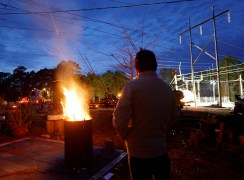By Scott Englund
Shortly after sunset on Saturday, December 3, 2022, two electric transformers in Moore County, North Carolina were repeatedly shot, leaving nearly 40,000 people without power. The local utility estimated that several thousand customers would remain in the dark for days, as nighttime temperatures fell below freezing. In a similar attack on April 16, 2013, the Metcalf Pacific Gas and Electric substation in Coyote, California was disabled when unidentified snipers fired more than 100 rounds at transformers and a container storing oil used to cool equipment, cutting power to thousands of people and causing an estimated $15 million in damage.
A motive for the December 2022 attack has not yet been established. Yet, it offers important lessons about the persistence of domestic terrorism, the vulnerability of U.S. infrastructure to attacks, and the need for imaginative counterterror efforts against a diversifying threat that includes new perpetrators and targets. The new 2021 National Strategy for Countering Domestic Terrorism has been a promising development.
The logic of terrorism
The concept of “terrorism” seems straightforward, yet a precise definition is the subject of debate. It is widely accepted to include violence or the threat of violence, toward some political, social, or religious end. Though terrorism is coercive, the targets of an attack are not necessarily the intended targets of the coercion. Targets of terror frequently did nothing to become a target, and could not avoid being a target. If people begin to question the state’s competence in protecting the public, or change their behavior in an attempt to avoid being targeted, those reactions are part of the logic of terrorist violence.
A recent online publication by an “accelerationist” group (white supremacists who wish to hasten the downfall of the current socio-political structure) encouraged readers to select targets “that do the most damage to the system and spark revolution and chaos. So long as the power turns on, the status quo, the downward decline of our race, and the increase in nonwhites in our lands will carry on unhindered.” The intention is to hasten social collapse.
The White House’s first National Strategy for Countering Domestic Terrorism assesses that the current threat comes from, in part, “racially or ethnically motivated violent extremists” whose ideologies are “rooted in a perception of the superiority of the white race that calls for violence in furtherance of perverse and abhorrent notions of racial ‘purity’ or ‘cleansing’.” The inevitability of a coming purification of society, and a restoration of fundamental truths leaves no space for half measures. This apocalyptic narrative has been espoused by groups as diverse as the Shining Path of Peru, the Islamic State in Iraq and Syria, and Aum Shinrikyo in Japan.
Infrastructure vulnerability
U.S. infrastructure is vulnerable, and effective attacks need not be sophisticated. The December 2022 attack on the North Carolina power grid could have easily been accomplished by one person with a legally-procured rifle and ammunition. The resulting damage, while not permanent or even long-lasting, was disruptive and dangerous. Though ultimately determined by the FBI not to be an act of terror, a Christmas 2020 bombing in Nashville severely damaged an AT&T transmission center that disabled cellular telephone networks throughout the central and southern United States for several hours.
Over the past 50 years, U.S. infrastructure has been consistently subject to attack, though at a relatively low number of incidents per year. According to the Global Terrorism Database, between 1970 and 2020 there have been 102 attacks on U.S. infrastructure, at least 60 of which targeted the electrical grid. Since 2009, there has been a period of increased attacks on all targets in the United States — and infrastructure, specifically. Infrastructure attacks rose 70% in 2022 compared to 2021, according to Politico.
The Department of Homeland Security’s Cyber and Infrastructure Security Agency (CISA) monitors 16 critical infrastructure sectors, including energy, food and agriculture, critical manufacturing, and financial services. CISA prioritizes critical infrastructure by weighing five considerations: 1) the safety and well-being of individuals in the community; 2) the value of an asset in the context of a community, region, or nation as a whole; 3) the effect of the loss of an asset on operations and dependencies, 4) the economic impact of a disruption of a service or asset, and 5) the general impact of the loss of a service or asset on a community or larger critical infrastructure sector. The loss of power transformers would rank very high in this risk framework and touch multiple critical infrastructure sectors.
The accelerationist handbook cited above encouraged attacks against the energy infrastructure sector as being “sitting ducks, worthy prey” and “largely unprotected and often in remote locations.” North Carolina Governor Roy Cooper summarized the situation: “If someone with a firearm can do this much damage and get power out to tens of thousands of people, then obviously we need to look at the different layers of infrastructure and hardening and make better decisions here.” The Duke Energy facility in North Carolina had sensibly prioritized keeping people safely away from the dangerous equipment on site. However, inexpensive pre-formed concrete barriers would have protected it against a relatively simple attack like the one that occurred in December 2022. On December 15, 2022 the Federal Energy Regulatory Commission ordered the North American Electric Reliability Corporation to study physical reliability standards at the nationwide power grid and determine if improvements were necessary.
The legacy of 9/11
According to the Global Terrorism Database, between 2014 and 2020, there was an annual average of 20 terror attacks worldwide in which a vehicle was the primary or secondary weapon. In that same period, vehicles killed 277 people in terror attacks. Before 2014, such attacks averaged less than two per year. Since at least 2010, terror groups have encouraged the use of vehicles to attack civilians. Just as the 9/11 commission concluded that a “failure of imagination” blinded the U.S. national security enterprise to the September 11, 2001 terror attack vector, we risk repeating those failures. Like using a truck to run pedestrians down in a crowded place, the December 2022 attack against an electric grid in North Carolina is notable by its simplicity, accessibility, and effectiveness.
This evolving threat has implications for counterterrorism and homeland security. Unfortunately, the United States has a long history of violence toward African-American and Jewish religious institutions. As illustrated in the chart above, religious institutions are the second-most targeted facility in the United States, followed by a general category of “businesses,” which includes places such as the Walmart attacked in El Paso, Texas in 2019, and the Pulse LGBTQ nightclub in Orlando, Florida in 2016. These targets are notable for the specificity of patrons, as indicated in comments by assailants, and the fact that they were relatively defenseless. In the Global Terrorism Database, the “private citizens and property” and “businesses” categories often includes attacks against these targets because of their perceived association with certain groups, most often people of color, the Jewish community, and LGBTQ community.
Domestic counterterrorism is, by design, difficult to detect. A low-profile effort does not provide the same exhilarating satisfaction of a bunker-busting bomb, but is nevertheless effective. In 2021, U.S. President Joe Biden’s administration released a policy document focused entirely on countering domestic terrorism. First, it set out a four-point counterterrorism strategy. Second, it unequivocally stated that right-wing, racially motivated, and anti-government violent groups present the biggest threat. Finally, it recommended that the federal government address inequality experienced by marginalized U.S. populations.
This final feature presents two challenges. One, a campaign to resolve structural injustices felt by marginalized groups could further alienate those who identify with right-wing white-grievance politics, but do not endorse violence. Two, in the United States, local, state, and federal governments have a long history of directly engaging in, and later tolerating, domestic terror against people of color or other marginalized groups. Given that history of state terror, attempts to address inequality may be met with mistrust in these communities, no matter how well-intentioned.
Conclusion
The Biden administration’s decision to publish a domestic counterterror strategy shows how much the U.S. government’s response to the threat of terrorist violence has changed since 2001. While countering domestic terrorism has risen as a national priority, transnational terrorist threats against Americans and U.S. interests remain. Properly defining and understanding a threat is essential to developing countermeasures. Protecting the public against domestic terrorism requires an approach very different from the approach used against transnational terror organizations such as al-Qaida or the Islamic State. Patient law enforcement activity, coupled with well-crafted communication efforts, could help achieve this goal.
This is the opinion of the author alone and does not represent official policy of the Office of the Director of National Intelligence or the United States Government. The United States Government does not endorse or warrant any links embedded in this article and is not responsible for the content there found.












